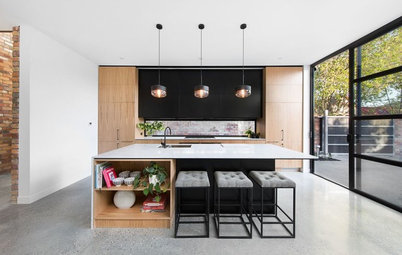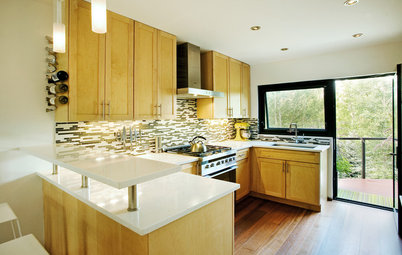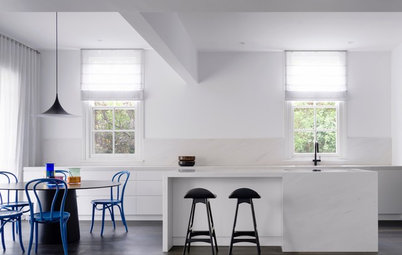How Do I... Choose Cabinetry for a Dark Kitchen Floor?
A kitchen designer reveals the hottest cabinetry colours for dark floors, and how to choose between them
Dark floors are a hugely popular choice for kitchens right now, but which cabinetry should you select to go with them? With so many different looks available to you, it’s easy to feel overwhelmed. We’ve asked kitchen expert Chris Ruffé, director of Bondi Kitchens, to pinpoint the hottest cabinetry colours and finishes to go with a dark floor, and provide some tips on how to make the selection process easier.
The Importance of Balance
Balance is essential. With a dark floor, consider lighter cabinetry and a dark benchtop, or opt for dark cabinetry and a light benchtop.
You should also try to avoid a matchy-matchy look. If you want to match a dark floor with dark cabinetry, go for complementary finishes rather than matching ones, which have a tendency to bleed into one another. You could, for example, pair a dark timber floor with burnt oak veneer cabinets and a Caesarstone benchtop in ‘Raw Concrete’.
Balance is essential. With a dark floor, consider lighter cabinetry and a dark benchtop, or opt for dark cabinetry and a light benchtop.
You should also try to avoid a matchy-matchy look. If you want to match a dark floor with dark cabinetry, go for complementary finishes rather than matching ones, which have a tendency to bleed into one another. You could, for example, pair a dark timber floor with burnt oak veneer cabinets and a Caesarstone benchtop in ‘Raw Concrete’.
Whitewashed cabinetry
Applying a whitewash paint finish to timber veneer is an appealing option for a kitchen with a dark floor, and looks particularly effective with Shaker-style cabinetry. It’s a timeless style that allows you to add interest with colour and texture in lighting and seating – items that are easy to swap out down the track.
Applying a whitewash paint finish to timber veneer is an appealing option for a kitchen with a dark floor, and looks particularly effective with Shaker-style cabinetry. It’s a timeless style that allows you to add interest with colour and texture in lighting and seating – items that are easy to swap out down the track.
Deep darks
Dark-coloured cabinetry such as navy, black and deep-green, in a semi-matt finish, is a great option for dark floors. It looks beautiful matched with a statement marble benchtop and brass hardware.
The 8 Biggest Kitchen Blunders
Dark-coloured cabinetry such as navy, black and deep-green, in a semi-matt finish, is a great option for dark floors. It looks beautiful matched with a statement marble benchtop and brass hardware.
The 8 Biggest Kitchen Blunders
Bluish grey
A look many of our clients are loving right now is matt lacquer cabinetry in bluish-grey shades. Porter’s Paints ‘French Slate’ is an appealing choice. When paired with a vivid white benchtop, blue-grey is the perfect way to ground a dark floor.
A look many of our clients are loving right now is matt lacquer cabinetry in bluish-grey shades. Porter’s Paints ‘French Slate’ is an appealing choice. When paired with a vivid white benchtop, blue-grey is the perfect way to ground a dark floor.
Weathered finishes
Raw, aged finishes are an emerging trend in kitchen cabinetry right now. They give your kitchen a warm, laid-back look and feel. We’re loving cabinetry in American oak timber veneer (a warm mid-tone), paired with matt-black panelling, aged brass hardware, and a dark floor.
Raw, aged finishes are an emerging trend in kitchen cabinetry right now. They give your kitchen a warm, laid-back look and feel. We’re loving cabinetry in American oak timber veneer (a warm mid-tone), paired with matt-black panelling, aged brass hardware, and a dark floor.
Mixed materials
Layering different finishes is a huge trend in kitchens right now. In our work, we’ve mixed timber cabinets with a raw concrete floor, a marble benchtop, and a grey mirrored splashback, which is a scheme that really works.
Materials can really set the mood in a space and define how you want specific areas to be used. For example, slick and hygienic surfaces such as Corian or stainless steel are great around sinks and cooking or prep zones, while raw materials such as timber veneer and painted melamine are ideal for cabinetry and storage.
Split-material benchtops are another emerging trend, where you might combine timber and concrete in the one surface.
Layering different finishes is a huge trend in kitchens right now. In our work, we’ve mixed timber cabinets with a raw concrete floor, a marble benchtop, and a grey mirrored splashback, which is a scheme that really works.
Materials can really set the mood in a space and define how you want specific areas to be used. For example, slick and hygienic surfaces such as Corian or stainless steel are great around sinks and cooking or prep zones, while raw materials such as timber veneer and painted melamine are ideal for cabinetry and storage.
Split-material benchtops are another emerging trend, where you might combine timber and concrete in the one surface.
What to consider
When you’re choosing a colour for your kitchen cabinets, it’s vital to consider all the other elements in the room, such as the flooring, benchtop material, wall colour and light fittings. Start by laying out all your samples and paint chips on a table so you can see how everything sits together.
When you’re choosing a colour for your kitchen cabinets, it’s vital to consider all the other elements in the room, such as the flooring, benchtop material, wall colour and light fittings. Start by laying out all your samples and paint chips on a table so you can see how everything sits together.
You’d be surprised at how often a material works beautifully on its own, but just doesn’t sit well next to another one.
But if you have one ‘must-have’ material – say, for your benchtop or cabinetry – use this as an anchor to steer your selection of the other finishes in the room.
Browse more kitchen cabinetry
But if you have one ‘must-have’ material – say, for your benchtop or cabinetry – use this as an anchor to steer your selection of the other finishes in the room.
Browse more kitchen cabinetry
Options in Kitchen Cabinetry Materials
Melamine chipboard
Pros: Cheap, lightweight and sturdy.
Cons: Chips easily.
Tip: Use solid panels for your cabinet internals, with a minimum thickness of 16 millimetres for longevity and strength.
Timber veneer
Pros: A real timber finish, but without the hefty price tag of the solid variety; also has a more consistent finish than solid timber.
Cons: Can yellow and fade over time if not properly sealed.
Tip: Consider the size of the timber grain carefully – it will look very different on a large scale than it does on a small sample.
Engineered board
Pros: Incredibly durable, long-lasting, easy to clean, won’t chip or fade; lots of decorative options.
Cons: Hard to fix if chipped, can look artificial.
Tip: Don’t worry too much about which brand to choose – they all have a fairly similar finish.
Melamine chipboard
Pros: Cheap, lightweight and sturdy.
Cons: Chips easily.
Tip: Use solid panels for your cabinet internals, with a minimum thickness of 16 millimetres for longevity and strength.
Timber veneer
Pros: A real timber finish, but without the hefty price tag of the solid variety; also has a more consistent finish than solid timber.
Cons: Can yellow and fade over time if not properly sealed.
Tip: Consider the size of the timber grain carefully – it will look very different on a large scale than it does on a small sample.
Engineered board
Pros: Incredibly durable, long-lasting, easy to clean, won’t chip or fade; lots of decorative options.
Cons: Hard to fix if chipped, can look artificial.
Tip: Don’t worry too much about which brand to choose – they all have a fairly similar finish.
Solid timber (such as oak, blackbutt, spotted gum, cedar)
Pros: Rich textures, flexible, some species are naturally waterproof, ages beautifully.
Cons: Expensive, heavy, can require maintenance, unhygienic if used incorrectly.
Tip: Solid timbers are suited to different environments, for example some might warp in humid conditions, so consider your environment carefully.
MDF
Pros: Cheap, huge range of colour options, good for painted finishes, available in different thicknesses.
Cons: Not recommended for outdoor or wet areas (there are some new MDFs that are moisture-resistant, but this doesn’t mean they are waterproof).
Tip: For durability, choose ‘MR MDF’, which is moisture resistant.
Pros: Rich textures, flexible, some species are naturally waterproof, ages beautifully.
Cons: Expensive, heavy, can require maintenance, unhygienic if used incorrectly.
Tip: Solid timbers are suited to different environments, for example some might warp in humid conditions, so consider your environment carefully.
MDF
Pros: Cheap, huge range of colour options, good for painted finishes, available in different thicknesses.
Cons: Not recommended for outdoor or wet areas (there are some new MDFs that are moisture-resistant, but this doesn’t mean they are waterproof).
Tip: For durability, choose ‘MR MDF’, which is moisture resistant.
Tell us
Are you planning a kitchen reno? Tell us about it in the Comments section below. And while you’re at it, don’t forget to like, bookmark or share this story. Join the conversation.
More
Browse more kitchen stories
Are you planning a kitchen reno? Tell us about it in the Comments section below. And while you’re at it, don’t forget to like, bookmark or share this story. Join the conversation.
More
Browse more kitchen stories






















A kitchen is a big investment, so it pays to stick with fairly neutral tones for a look that won’t date. When it comes to trends, go for small doses, such as handles and tapware. When choosing materials for your cabinetry and benchtop, don’t overcomplicate things with too many different materials, colours and finishes.
It’s also important for the kitchen to feel like an extension of the rest of your home, so factor in surrounding colours and finishes.